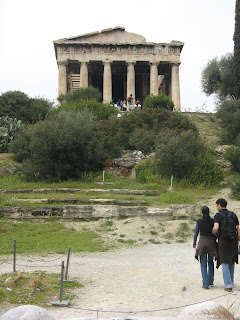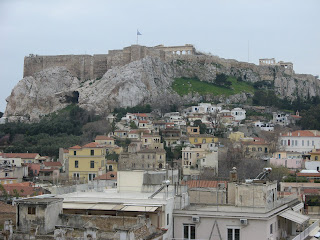The overcast morning looked rather threatening, but the reception desk person assured that there wouldn't be any rain. It seems that these clouds have come from over the Saharan desert with very little moisture but containing lots of fine sand and dust particles. He said that if there was some rain, everything would be covered with yellow dirt after the shower. Fortunately, his forecast was correct.
And the protest of the day was by an anarchist group that had caused a great deal of trouble in December that led to a number of burned buildings. Apparently, a Greek police officer shot an unarmed teenager and the black-flag group seized upon that as an opportunity to take to the streets. They were across the street from the Parliament Building in Syntagma Square and brought tents to camp out overnight. As you might expect, police and army units were plentiful. I took a few pics and then chose to walk around the square for the rest of the day and night.

Most of the morning and early afternoon was spent at the Benaki Museum, which many seem to prefer over the National Archeology Museum because of its more manageable size. The museum is housed in a former mansion owned by the Benaki family across the street from the Parliament Building; the initial collection of historical artifacts was of items gathered by the family for its own use.




Typical of the exhibits is this array of ancient battle helmets. Does the far right one remind you of Jane Curtin and Chevy Chase somehow?

An incredible mosaic of the Virgin and Child dated 867 AD from Hagia Sophie Church in Constantinople.
Just to illustrate that even curators have some sense of humor, scattered throughout the museum were sculpture pieces made of wire and covered in children's clothing to represent what children might actually be doing relative to the particular item in the exhibit.




Kinda, sorta behind the Benaki Museum was an upscale shopping/restaurant area which led to the Church of St. Dionysius, the patron saint of Athens. On the way, these two American classics (a 1955 Chevrolet and a 1961 Thunderbird) sat forlornly.
Church of St. Dionysus
After leaving the Benaki neighborhood, I walked down to the neighborhood of ancient Roman-era ruins not far from the base of the Acropolis. As in much of the world it had occupied, the Romans erected their public buildings in their own style. Fortunately, they left more written documentation about their projects than most other cultures, so we have access to original plans.
Emperor Hadrian was probably the best-known Roman leader in terms of building across the Empire from as far north as Hadrian's Wall in Scotland down to Saharan Africa and the Middle East. No exception here. One ruin was of a large library, although that site isn't particularly well preserved or rebuilt.
Emperor Hadrian was probably the best-known Roman leader in terms of building across the Empire from as far north as Hadrian's Wall in Scotland down to Saharan Africa and the Middle East. No exception here. One ruin was of a large library, although that site isn't particularly well preserved or rebuilt.
Adjacent to the library is the Roman Forum, a commercial area common to all the areas which Rome occupied. Part of the original entry gate still stands.
In the Forum area is one of the city's most famous monuments, the octagonal Tower of the Winds. Built in 50 B.C., it has personifications of the winds on each side and a water clock inside.
In the era before zoning ordinances, it seems most anything went. The Tower of Winds was originally a church and next to it was a civic asset common to Roman communities -- the public latrine. This was a square-shaped building with a courtyard in the middle and the capacity to serve sixty-eight citizens simultaneously. In addition to fulfilling its obvious purpose, the latrine was also a popular social gathering location. I'm not sure if the stone "seat" in this picture is genuine -- and didn't want to ask.
The AGORA was Athen's marketplace and general center of the city since the 6th century B.C. Socrates would often address the public here and it was functioning for over 1200 years. The best-preserved Classic temple in Greece is at the top of the Agora and is dedicated to Hephaestus, the god of fire.

This monument to Hadrian looked to be in excellent condition and leads you to believe it is a duplicate.


The top of the temple is illustrated with scenes of the deeds of Theseus and Herakles (Hercules in Roman mythology).

This monument to Hadrian looked to be in excellent condition and leads you to believe it is a duplicate.


The top of the temple is illustrated with scenes of the deeds of Theseus and Herakles (Hercules in Roman mythology).
The Acropolis overlooks the Agora area.
As is the case with most of Athen's public areas and museums, the Agora area closed at 3pm; on the way back to the hotel, I explored new territory and walked through one of the shopping area aimed at Athenians. It's been ages since the grocery stores here offered seafood this fresh, including an entire octopus. Gulp.
View of the Acropolis from the hotel ....

















When do you come back to USA?? How is the weather there (Spring like)???
ReplyDeleteThanks for info.
Tony in Richmond, Va
What Happended to April 1, 2, 3?? You should write a travel book.Tony
ReplyDelete